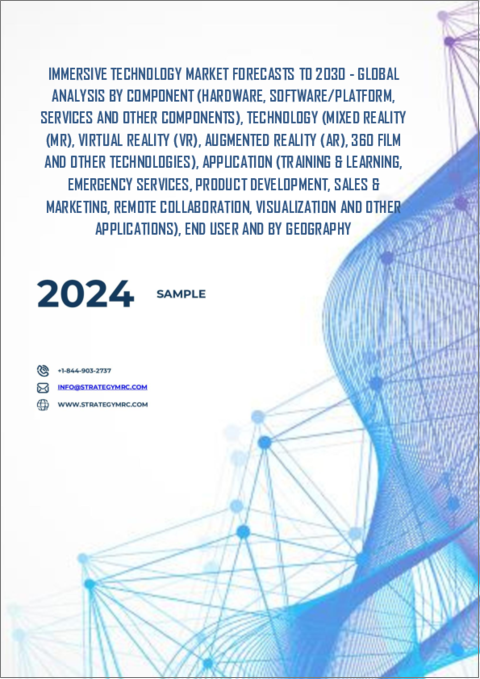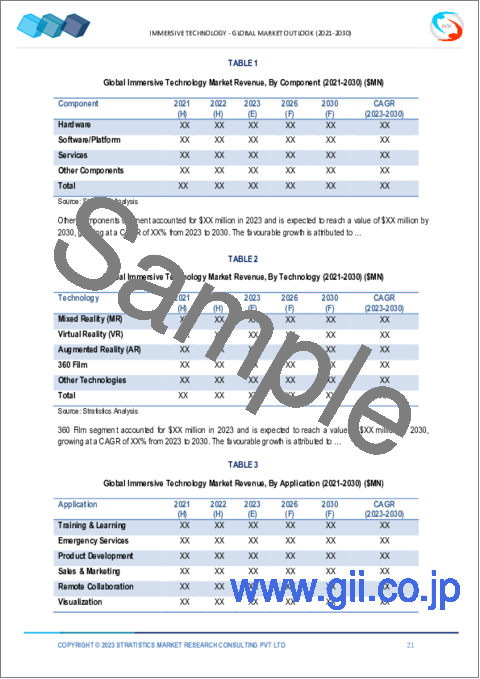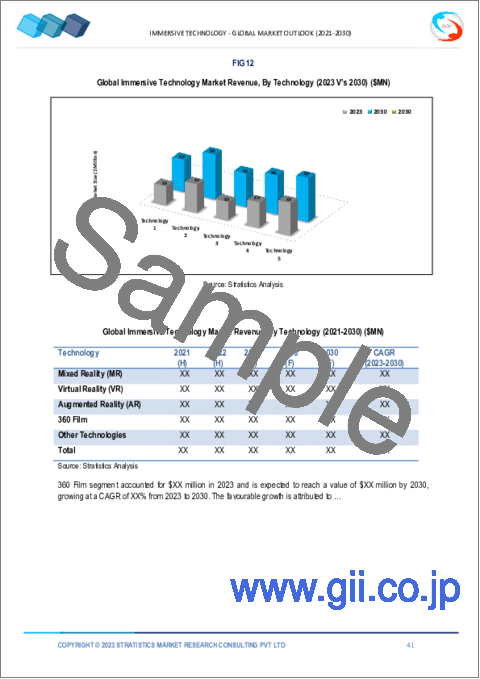|
|
市場調査レポート
商品コード
1383412
イマーシブ技術市場の2030年までの予測:コンポーネント別、技術別、用途別、エンドユーザー別、地域別の世界分析Immersive Technology Market Forecasts to 2030 - Global Analysis By Component, Technology (Mixed Reality, Virtual Reality, Augmented Reality, 360 Film and Other Technologies), Application, End User and By Geography |
||||||
カスタマイズ可能
|
|||||||
| イマーシブ技術市場の2030年までの予測:コンポーネント別、技術別、用途別、エンドユーザー別、地域別の世界分析 |
|
出版日: 2023年11月01日
発行: Stratistics Market Research Consulting
ページ情報: 英文 200+ Pages
納期: 2~3営業日
|
全表示
- 概要
- 図表
- 目次
Stratistics MRCによると、世界のイマーシブ技術市場は2023年に319億6,000万米ドルを占め、予測期間中のCAGRは20.46%で成長し、2030年には1,176億2,000万米ドルに達すると予測されています。
イマージョン技術と呼ばれる分析技術の一種は、360度の空間を使って体験を拡張したり、まったく新しい設定を作り出したりします。デバイス・ネットワーク上のコンテンツをどの角度からでも見ることができます。さらに、没入型技術によって、ユーザーの環境にデジタルビジュアルを重ねることで、リアルな体験を向上させることができます。外界から完全に隔離され、電子媒体に没入することで、顧客にとって新たな現実が確立されます。
ガートナーが2020年に作成したレポートによると、没入型体験は、人間の能力を増幅できる新しいモデルとプロセスによって、この分野を根本的に変える可能性を秘めた技術動向です。
没入型ゲームとエンターテインメント
没入型テクノロジーは、エンターテインメント業界におけるロケーションベースのエンターテインメント体験へと発展しています。VRやARは、テーマパークや娯楽施設のアトラクションに組み込まれ、ゲストにユニークな体験を提供しています。さらに、eスポーツがVRを採用したことで、仮想環境での競合ゲームに新たな機会が生まれました。様々なVRヘッドセットを持つプレーヤーが同じ仮想環境内でコミュニケーションすることを可能にするクロスプラットフォーム・ゲーミングの増加は、この成長のもう一つの指標です。
高価格からのスタート
没入型テクノロジー市場への参入を阻む大きな障壁のひとつは、やはり参入コストです。高品質のVRヘッドセットやARデバイスの導入は、特に消費者や中小企業にとっては、そのコストによって制約を受ける可能性があります。さらに、ハードウェアだけでなく、ソフトウェアやアクセサリーのアップグレードにも余分な費用がかかります。多くの潜在的ユーザーは、こうした高額な初期費用に尻込みする可能性があるため、特に価格に敏感な市場では、市場の拡大が遅れる可能性があります。
ハードウェアの技術進歩
ディスプレイ、グラフィック・プロセッサ、モーション・トラッキング・センサだけでなく、没入型技術のハードウェアも進歩しています。長時間の使用におけるVRヘッドセットの快適性を向上させるため、メーカーは重量、人間工学、バッテリー寿命の限界に挑み続けています。さらに、触覚フィードバックや技術の進歩により、ユーザーはバーチャル環境で身体感覚を体験できるようになり、没入感が向上しています。スタンドアロンのVRやARデバイスを可能にすることで、これらのハードウェアの進歩は、外部コンピュータやコンソールの必要性も減らしています。
データセキュリティとプライバシーへの懸念
没入型技術デバイスやアプリケーションによって収集された個人データや生体情報は悪用される可能性があり、プライバシーに関する懸念が生じる。これらの技術が収集する個人データはかなりの量にのぼるため、データの悪用、侵害、不正アクセスのリスクが高まる。しかし、こうした懸念を和らげ、ユーザーの信頼を維持するためには、より強力な暗号化、よりオープンなデータポリシー、より厳格なポリシーが必要です。
COVID-19の影響:
没入型テクノロジーの市場は、COVID-19の流行によって複雑な影響を受けた。当初は、消費者支出の減少とサプライチェーンの混乱が市場に問題を引き起こしました。それにもかかわらず、遠隔医療、仮想イベント、遠隔作業、遠隔学習への没入型技術の採用は、パンデミックによって促進されました。さらに、こうした領域で没入型ソリューションへのニーズが高まったことで、投資やイノベーションが活発化し、持続的な拡大への基盤が築かれました。世界の健康危機は、地理的に遠隔で孤立した世界の障害を軽減する没入型技術の重要性を強調し、それによって多様な産業での活用に新たな展望を生み出しました。
トレーニング&学習分野が予測期間中最大になる見込み
トレーニング・学習分野が最大の市場シェアを占めています。専門スキル開発、企業トレーニング、教育機関など、幅広い用途をカバーしています。研修・学習業界では、バーチャルリアリティ(VR)や拡張現実(AR)などの没入型技術の利用が顕著に増加しており、ダイナミックで魅惑的な体験を提供することで、知識の定着やスキル開発を向上させています。さらに、医療トレーニング、教育シミュレーション、仮想教室、職業スキル開発などのアプリケーションを包含する没入型技術の中でも、重要かつ成長中の市場ニッチです。
ヘルスケア分野は予測期間中に最も高いCAGRが見込まれる
ヘルスケア産業のCAGRが最も高いです。没入型技術は、患者ケア、医療教育、遠隔医療に革命をもたらしました。この技術の例としては、仮想現実(VR)や拡張現実(AR)があります。液浸技術は、ヘルスケア業界で遠隔医療相談、疼痛管理、手術シミュレーション、治療介入などに広く利用されるようになっています。さらに、ヘルスケア部門は、患者中心のケア、手頃な価格のトレーニング、医療の進歩を重視するようになっているため、没入型技術市場の革新と成長の重要な分野となっています。
最大のシェアを持つ地域
北米は、没入型技術の採用と進歩により、市場で最大のシェアを占めています。同地域は研究開発への投資が盛んで、ハイテク企業のエコシステムも盛んで、VRとARの新興企業も多いです。主要な業界プレーヤー、ヘルスケア、教育、ゲーム、企業などの業界における広範な応用、技術に精通した顧客基盤などが、この地域の支配的な地位の要因となっています。
CAGRが最も高い地域:
没入型テクノロジー市場は、アジア太平洋地域で最も高いCAGRを示しています。この地域の人口が多く、技術的なリテラシーが高いこと、最先端技術への投資が増加していること、製造、ゲーム、教育などさまざまな分野で没入型ソリューションが採用されていることなどが、この急成長の要因となっています。中国、日本、韓国などのアジア太平洋地域が没入型技術革新で主導権を握っていること、同地域の中間層が急速に拡大し、没入型体験に対する需要が高まっていることから、同市場は今後数年間で大きく成長すると予想されます。
無料カスタマイズサービス:
本レポートをご購読のお客様には、以下の無料カスタマイズオプションのいずれかをご利用いただけます:
- 企業プロファイル
- 追加市場企業の包括的プロファイリング(3社まで)
- 主要企業のSWOT分析(3社まで)
- 地域セグメンテーション
- 顧客の関心に応じた主要国の市場推計・予測・CAGR(注:フィージビリティチェックによる)
- 競合ベンチマーキング
- 製品ポートフォリオ、地理的プレゼンス、戦略的提携に基づく主要企業のベンチマーキング
目次
第1章 エグゼクティブサマリー
第2章 序文
- 概要
- ステークホルダー
- 調査範囲
- 調査手法
- データマイニング
- データ分析
- データ検証
- 調査アプローチ
- 調査ソース
- 1次調査ソース
- 2次調査ソース
- 前提条件
第3章 市場動向分析
- 促進要因
- 抑制要因
- 機会
- 脅威
- 技術分析
- アプリケーション分析
- エンドユーザー分析
- 新興市場
- 新型コロナウイルス感染症(COVID-19)の影響
第4章 ポーターのファイブフォース分析
- 供給企業の交渉力
- 買い手の交渉力
- 代替品の脅威
- 新規参入業者の脅威
- 競争企業間の敵対関係
第5章 世界のイマーシブ技術市場:コンポーネント別
- ハードウェア
- ヘッドマウントディスプレイ(HMD)
- ジェスチャー追跡デバイス(GTD)
- プロジェクターとディスプレイウォール(PDW)
- ソフトウェア/プラットフォーム
- サービス
- プロ
- 管理された
- その他のコンポーネント
第6章 世界のイマーシブ技術市場:技術別
- 複合現実(MR)
- 仮想現実(VR)
- 拡張現実(AR)
- 360フィルム
- その他の技術
第7章 世界のイマーシブ技術市場:用途別
- トレーニングと学習
- 緊急サービス
- 製品開発
- セールス&マーケティング
- リモートコラボレーション
- 視覚化
- プロモーションと広告
- リモートアシスタンス
- コンテンツ制作
- メタバース
- その他の用途
第8章 世界のイマーシブ技術市場:エンドユーザー別
- ヘルスケア
- 小売・電子商取引
- 教育
- 建築
- メディア・エンターテイメント
- ゲーム
- 製造業
- 航空宇宙・防衛
- 自動車
- エネルギー
- その他のエンドユーザー
第9章 世界のイマーシブ技術市場:地域別
- 北米
- 米国
- カナダ
- メキシコ
- 欧州
- ドイツ
- 英国
- イタリア
- フランス
- スペイン
- その他の欧州
- アジア太平洋
- 日本
- 中国
- インド
- オーストラリア
- ニュージーランド
- 韓国
- その他のアジア太平洋
- 南米
- アルゼンチン
- ブラジル
- チリ
- その他の南米
- 中東・アフリカ
- サウジアラビア
- アラブ首長国連邦
- カタール
- 南アフリカ
- その他の中東・アフリカ
第10章 主な発展
- 契約、パートナーシップ、コラボレーション、合弁事業
- 買収と合併
- 新製品の発売
- 事業拡大
- その他の主要戦略
第11章 企業プロファイル
- Lockheed Martin Corporation
- Google LLC
- Acer Inc.
- FAAC Incorporated
- CM Labs Simulations Inc.
- HTC Corporation
- Varjo Technologies
- Immersive Technologies Pty Limited
- Zeality Inc
- EON Reality Inc.
- Atheer Inc.
- Sony Corporation
- Oculus(Facebook Technologies, LLC.)
- Samsung Group
- AVEVA Group PLC
- HCL Technologies Limited
- Honeywell International Inc.
- NCTech Limited
- Blippar Ltd.
- Magic Leap Inc.
List of Tables
- Table 1 Global Immersive Technology Market Outlook, By Region (2021-2030) ($MN)
- Table 2 Global Immersive Technology Market Outlook, By Component (2021-2030) ($MN)
- Table 3 Global Immersive Technology Market Outlook, By Hardware (2021-2030) ($MN)
- Table 4 Global Immersive Technology Market Outlook, By Head-Mounted Display (HMD) (2021-2030) ($MN)
- Table 5 Global Immersive Technology Market Outlook, By Gesture Tracking Devices (GTD) (2021-2030) ($MN)
- Table 6 Global Immersive Technology Market Outlook, By Projectors & Display Walls (PDW) (2021-2030) ($MN)
- Table 7 Global Immersive Technology Market Outlook, By Software/Platform (2021-2030) ($MN)
- Table 8 Global Immersive Technology Market Outlook, By Services (2021-2030) ($MN)
- Table 9 Global Immersive Technology Market Outlook, By Professional (2021-2030) ($MN)
- Table 10 Global Immersive Technology Market Outlook, By Managed (2021-2030) ($MN)
- Table 11 Global Immersive Technology Market Outlook, By Other Components (2021-2030) ($MN)
- Table 12 Global Immersive Technology Market Outlook, By Technology (2021-2030) ($MN)
- Table 13 Global Immersive Technology Market Outlook, By Mixed Reality (MR) (2021-2030) ($MN)
- Table 14 Global Immersive Technology Market Outlook, By Virtual Reality (VR) (2021-2030) ($MN)
- Table 15 Global Immersive Technology Market Outlook, By Augmented Reality (AR) (2021-2030) ($MN)
- Table 16 Global Immersive Technology Market Outlook, By 360 Film (2021-2030) ($MN)
- Table 17 Global Immersive Technology Market Outlook, By Other Technologies (2021-2030) ($MN)
- Table 18 Global Immersive Technology Market Outlook, By Application (2021-2030) ($MN)
- Table 19 Global Immersive Technology Market Outlook, By Training & Learning (2021-2030) ($MN)
- Table 20 Global Immersive Technology Market Outlook, By Emergency Services (2021-2030) ($MN)
- Table 21 Global Immersive Technology Market Outlook, By Product Development (2021-2030) ($MN)
- Table 22 Global Immersive Technology Market Outlook, By Sales & Marketing (2021-2030) ($MN)
- Table 23 Global Immersive Technology Market Outlook, By Remote Collaboration (2021-2030) ($MN)
- Table 24 Global Immersive Technology Market Outlook, By Visualization (2021-2030) ($MN)
- Table 25 Global Immersive Technology Market Outlook, By Promotion & Advertising (2021-2030) ($MN)
- Table 26 Global Immersive Technology Market Outlook, By Remote Assistance (2021-2030) ($MN)
- Table 27 Global Immersive Technology Market Outlook, By Content Creation (2021-2030) ($MN)
- Table 28 Global Immersive Technology Market Outlook, By Metaverse (2021-2030) ($MN)
- Table 29 Global Immersive Technology Market Outlook, By Other Applications (2021-2030) ($MN)
- Table 30 Global Immersive Technology Market Outlook, By End User (2021-2030) ($MN)
- Table 31 Global Immersive Technology Market Outlook, By Healthcare (2021-2030) ($MN)
- Table 32 Global Immersive Technology Market Outlook, By Retail & Ecommerce (2021-2030) ($MN)
- Table 33 Global Immersive Technology Market Outlook, By Education (2021-2030) ($MN)
- Table 34 Global Immersive Technology Market Outlook, By Construction (2021-2030) ($MN)
- Table 35 Global Immersive Technology Market Outlook, By Media & Entertainment (2021-2030) ($MN)
- Table 36 Global Immersive Technology Market Outlook, By Gaming (2021-2030) ($MN)
- Table 37 Global Immersive Technology Market Outlook, By Manufacturing (2021-2030) ($MN)
- Table 38 Global Immersive Technology Market Outlook, By Aerospace & Defense (2021-2030) ($MN)
- Table 39 Global Immersive Technology Market Outlook, By Automotive (2021-2030) ($MN)
- Table 40 Global Immersive Technology Market Outlook, By Energy (2021-2030) ($MN)
- Table 41 Global Immersive Technology Market Outlook, By Other End Users (2021-2030) ($MN)
Note: Tables for North America, Europe, APAC, South America, and Middle East & Africa Regions are also represented in the same manner as above.
According to Stratistics MRC, the Global Immersive Technology Market is accounted for $31.96 billion in 2023 and is expected to reach $117.62 billion by 2030 growing at a CAGR of 20.46% during the forecast period. A type of analytical technique called immersion technology uses 360 degrees of space to expand on an experience or create an entirely new setting. Viewing content on the device network is possible from any angle. Additionally, realistic experiences can be improved by immersive technology by overlaying digital visuals over the user's environment. Through complete seclusion from the outside world and immersion in an electronic medium, this establishes a new reality for the client.
According to a report prepared in 2020 by Gartner, immersive experiences are a technological trend that withholds potential to radically change the sector, with new models and processes able to amplify human capabilities.
Market Dynamics:
Driver:
Immersing games and entertainment
Immersion technology has developed into location-based entertainment experiences in the entertainment industry. VR and AR are being incorporated into attractions at theme parks and entertainment venues to give guests unique experiences. Additionally, the adoption of VR by eSports has created new opportunities for competitive gaming in virtual environments. An increase in cross-platform gaming, which enables players with various VR headsets to communicate within the same virtual environment, is another indicator of this growth.
Restraint:
High starting prices
One major barrier to entry in the immersive technology market is still the cost of entry. Adoption of high-quality VR headsets and AR devices can be constrained by their cost, particularly for consumers and small businesses. Moreover, upgrades to the hardware as well as software and accessories come at extra expense. Since many potential users may be turned off by these expensive initial costs, market expansion may be slowed, especially in price-sensitive markets.
Opportunity:
Technological progress in hardware
Beyond displays, graphics processors, and motion-tracking sensors, immersive technology hardware has advanced. In order to improve VR headset comfort for prolonged use, manufacturers are continuously pushing the limits of weight, ergonomics, and battery life. Furthermore, haptic feedback and technological advancements improve immersion by allowing users to experience physical sensations in virtual environments. By enabling standalone VR and AR devices, these hardware advancements are also lessening the need for external computers or consoles.
Threat:
Data security and privacy concerns
Personal data and biometric information gathered by immersive technology devices and applications may be misused, raising privacy concerns. The considerable quantity of private data that these technologies collect increases the risk of misuse, breaches, and illegal access to data. However, to allay these worries and preserve user confidence, stronger encryption, more open data policies, and stricter policies are necessary.
COVID-19 Impact:
The market for immersive technology was affected by the COVID-19 pandemic in a complicated way. At first, lower consumer spending and supply chain disruptions caused problems for the market. The adoption of immersive technology for telehealth, virtual events, remote work, and distance learning was nevertheless expedited by the pandemic. Moreover, the heightened need for immersive solutions in these domains stimulated investments and innovations, thereby laying the groundwork for sustained expansion. The global health crisis underscored the importance of immersive technology in mitigating the obstacles of a geographically remote and isolated world, thereby creating novel prospects for its utilization across diverse industries.
The Training & Learning segment is expected to be the largest during the forecast period
The training and learning segment has the largest market share. It covers a broad spectrum of applications, including specialized skill development, corporate training, and educational institutions. The training and learning industry has seen a notable increase in the use of immersive technology, such as virtual reality (VR) and augmented reality (AR), which provide dynamic and captivating experiences that improve knowledge retention and skill development. Additionally, it is a crucial and growing market niche within immersive technology, encompassing applications like medical training, educational simulations, virtual classrooms, and vocational skill development.
The Healthcare segment is expected to have the highest CAGR during the forecast period
The healthcare industry has seen the highest CAGR. Immersion technology has revolutionized patient care, medical education, and telemedicine. Examples of this technology include virtual reality (VR) and augmented reality (AR). Immersion technology has become widely used in the healthcare industry for telehealth consultations, pain management, surgical simulations, and therapeutic interventions. Moreover, the healthcare sector is a key area for innovation and growth in the immersive technology market because of its increasing emphasis on patient-centric care, affordable training, and medical advancements.
Region with largest share:
North America holds the largest market share in the market, due to the adoption and advancement of immersive technology. The area has significant investments in R&D, a thriving ecosystem of tech companies, and a significant number of VR and AR startups. Key industry players, broad application in industries like healthcare, education, gaming, and enterprise, and a tech-savvy customer base are all factors that contribute to its dominant position.
Region with highest CAGR:
The immersive technology market has shown the highest CAGR in the Asia-Pacific region, owing to the region's sizable and technologically literate populace, rising investments in cutting-edge technologies, and the adoption of immersive solutions in a variety of sectors, such as manufacturing, gaming, and education, are all responsible for this quick growth. As a result of the Asia-Pacific region's leadership in immersive technology innovation countries like China, Japan, and South Korea and the region's rapidly expanding middle class and rising demand for immersive experiences, the market is expected to grow significantly in the coming years.
Key players in the market
Some of the key players in Immersive Technology market include: Lockheed Martin Corporation, Google LLC, Acer Inc., FAAC Incorporated, CM Labs Simulations Inc., HTC Corporation, Varjo Technologies, Immersive Technologies Pty Limited, Zeality Inc, EON Reality Inc., Atheer Inc., Sony Corporation, Oculus (Facebook Technologies, LLC.), Samsung Group, AVEVA Group PLC, HCL Technologies Limited, Honeywell International Inc., NCTech Limited, Blippar Ltd. and Magic Leap Inc.
Key Developments:
In October 2023, CM Labs Simulations has unveiled the Intellia Instructor, a software program serving as a component of a next-generation training management system. Intellia Instructor works in concert with CM Labs suite of Training Packs and Vortex Training Simulators to provide a methodology for organizations in the Construction and Utilities market.
In June 2023, Honeywell International Inc. HON has entered into a definitive agreement to acquire heads-up-display (HUD) assets of Swedish aerospace and defense company Saab Technology. The financial terms of the transaction are kept under wraps. The HUD system reduces the workload for pilots, helps them with increased situational awareness and increases flight safety.
In March 2023, Varjo Technologies and Leonardo have announced today that they are joining forces to enhance the capability of Leonardo's aircraft training devices through industry-leading mixed reality technology from Varjo. This agreement continues to strengthen and improve Leonardo's capabilities in the Simulation and Training domain.
Components Covered:
- Hardware
- Software/Platform
- Services
- Other Components
Technologies Covered:
- Mixed Reality (MR)
- Virtual Reality (VR)
- Augmented Reality (AR)
- 360 Film
- Other Technologies
Applications Covered:
- Training & Learning
- Emergency Services
- Product Development
- Sales & Marketing
- Remote Collaboration
- Visualization
- Promotion & Advertising
- Remote Assistance
- Content Creation
- Metaverse
- Other Applications
End Users Covered:
- Healthcare
- Retail & Ecommerce
- Education
- Construction
- Media & Entertainment
- Gaming
- Manufacturing
- Aerospace & Defense
- Automotive
- Energy
- Other End Users
Regions Covered:
- North America
- US
- Canada
- Mexico
- Europe
- Germany
- UK
- Italy
- France
- Spain
- Rest of Europe
- Asia Pacific
- Japan
- China
- India
- Australia
- New Zealand
- South Korea
- Rest of Asia Pacific
- South America
- Argentina
- Brazil
- Chile
- Rest of South America
- Middle East & Africa
- Saudi Arabia
- UAE
- Qatar
- South Africa
- Rest of Middle East & Africa
What our report offers:
- Market share assessments for the regional and country-level segments
- Strategic recommendations for the new entrants
- Covers Market data for the years 2021, 2022, 2023, 2026, and 2030
- Market Trends (Drivers, Constraints, Opportunities, Threats, Challenges, Investment Opportunities, and recommendations)
- Strategic recommendations in key business segments based on the market estimations
- Competitive landscaping mapping the key common trends
- Company profiling with detailed strategies, financials, and recent developments
- Supply chain trends mapping the latest technological advancements
Free Customization Offerings:
All the customers of this report will be entitled to receive one of the following free customization options:
- Company Profiling
- Comprehensive profiling of additional market players (up to 3)
- SWOT Analysis of key players (up to 3)
- Regional Segmentation
- Market estimations, Forecasts and CAGR of any prominent country as per the client's interest (Note: Depends on feasibility check)
- Competitive Benchmarking
- Benchmarking of key players based on product portfolio, geographical presence, and strategic alliances
Table of Contents
1 Executive Summary
2 Preface
- 2.1 Abstract
- 2.2 Stake Holders
- 2.3 Research Scope
- 2.4 Research Methodology
- 2.4.1 Data Mining
- 2.4.2 Data Analysis
- 2.4.3 Data Validation
- 2.4.4 Research Approach
- 2.5 Research Sources
- 2.5.1 Primary Research Sources
- 2.5.2 Secondary Research Sources
- 2.5.3 Assumptions
3 Market Trend Analysis
- 3.1 Introduction
- 3.2 Drivers
- 3.3 Restraints
- 3.4 Opportunities
- 3.5 Threats
- 3.6 Technology Analysis
- 3.7 Application Analysis
- 3.8 End User Analysis
- 3.9 Emerging Markets
- 3.10 Impact of Covid-19
4 Porters Five Force Analysis
- 4.1 Bargaining power of suppliers
- 4.2 Bargaining power of buyers
- 4.3 Threat of substitutes
- 4.4 Threat of new entrants
- 4.5 Competitive rivalry
5 Global Immersive Technology Market, By Component
- 5.1 Introduction
- 5.2 Hardware
- 5.2.1 Head-Mounted Display (HMD)
- 5.2.2 Gesture Tracking Devices (GTD)
- 5.2.3 Projectors & Display Walls (PDW)
- 5.3 Software/Platform
- 5.4 Services
- 5.4.1 Professional
- 5.4.2 Managed
- 5.5 Other Components
6 Global Immersive Technology Market, By Technology
- 6.1 Introduction
- 6.2 Mixed Reality (MR)
- 6.3 Virtual Reality (VR)
- 6.4 Augmented Reality (AR)
- 6.5 360 Film
- 6.6 Other Technologies
7 Global Immersive Technology Market, By Application
- 7.1 Introduction
- 7.2 Training & Learning
- 7.3 Emergency Services
- 7.4 Product Development
- 7.5 Sales & Marketing
- 7.6 Remote Collaboration
- 7.7 Visualization
- 7.8 Promotion & Advertising
- 7.9 Remote Assistance
- 7.10 Content Creation
- 7.11 Metaverse
- 7.12 Other Applications
8 Global Immersive Technology Market, By End User
- 8.1 Introduction
- 8.2 Healthcare
- 8.3 Retail & Ecommerce
- 8.4 Education
- 8.5 Construction
- 8.6 Media & Entertainment
- 8.7 Gaming
- 8.8 Manufacturing
- 8.9 Aerospace & Defense
- 8.10 Automotive
- 8.11 Energy
- 8.12 Other End Users
9 Global Immersive Technology Market, By Geography
- 9.1 Introduction
- 9.2 North America
- 9.2.1 US
- 9.2.2 Canada
- 9.2.3 Mexico
- 9.3 Europe
- 9.3.1 Germany
- 9.3.2 UK
- 9.3.3 Italy
- 9.3.4 France
- 9.3.5 Spain
- 9.3.6 Rest of Europe
- 9.4 Asia Pacific
- 9.4.1 Japan
- 9.4.2 China
- 9.4.3 India
- 9.4.4 Australia
- 9.4.5 New Zealand
- 9.4.6 South Korea
- 9.4.7 Rest of Asia Pacific
- 9.5 South America
- 9.5.1 Argentina
- 9.5.2 Brazil
- 9.5.3 Chile
- 9.5.4 Rest of South America
- 9.6 Middle East & Africa
- 9.6.1 Saudi Arabia
- 9.6.2 UAE
- 9.6.3 Qatar
- 9.6.4 South Africa
- 9.6.5 Rest of Middle East & Africa
10 Key Developments
- 10.1 Agreements, Partnerships, Collaborations and Joint Ventures
- 10.2 Acquisitions & Mergers
- 10.3 New Product Launch
- 10.4 Expansions
- 10.5 Other Key Strategies
11 Company Profiling
- 11.1 Lockheed Martin Corporation
- 11.2 Google LLC
- 11.3 Acer Inc.
- 11.4 FAAC Incorporated
- 11.5 CM Labs Simulations Inc.
- 11.6 HTC Corporation
- 11.7 Varjo Technologies
- 11.8 Immersive Technologies Pty Limited
- 11.9 Zeality Inc
- 11.10 EON Reality Inc.
- 11.11 Atheer Inc.
- 11.12 Sony Corporation
- 11.13 Oculus (Facebook Technologies, LLC.)
- 11.14 Samsung Group
- 11.15 AVEVA Group PLC
- 11.16 HCL Technologies Limited
- 11.17 Honeywell International Inc.
- 11.18 NCTech Limited
- 11.19 Blippar Ltd.
- 11.20 Magic Leap Inc.






